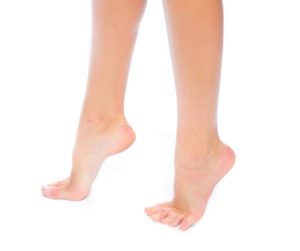Understanding Toe Walking in Children
Many parents and teachers frequently raise concerns in relation to toe walking. Toe walking can range from a normal developmental phase to a serious issue.
What is toe walking?
 Toe walking is when a child walks on his tiptoes with their heels raised off the ground. They are using only the balls of their feet to walk and are not placing weight on any other part of their foot. Typically, we may see children going through this developmental stage when they are learning to walk, and it can remain up until the age of three. Research suggests that up to 90% of children may toe walk at the age of two. It is advised that if your child is still toe walking after the age of three then you should consult a doctor, physiotherapist or podiatrist.
Toe walking is when a child walks on his tiptoes with their heels raised off the ground. They are using only the balls of their feet to walk and are not placing weight on any other part of their foot. Typically, we may see children going through this developmental stage when they are learning to walk, and it can remain up until the age of three. Research suggests that up to 90% of children may toe walk at the age of two. It is advised that if your child is still toe walking after the age of three then you should consult a doctor, physiotherapist or podiatrist.
Why do kids toe walk?
There are several different reasons for toe walking and it is important that it is fully investigated to find the cause before a solution can be identified.
Idiopathic/habitual – Idiopathic refers to when there is no know medical cause for toe walking and it is considered to be more habitual. Research suggests that if a child is able to walk in the typical heel-to-toe pattern when asked then this is a habit and can resolve naturally before adulthood.
Tight Achilles Tendon – the Achilles tendon attaches the calf muscle to the back of the heel. If there is tightness in this then it can lead to a tight calf muscle and raising of the heel. This will stop the heel making contact with the ground when walking. This should be examined by a physiotherapist.
Muscle and nerve problems – if there is an underlying muscle or nerve issue tis can cause tightness of the muscles and as with a tight achilles tendon this will raise the hell and stop it making contact with the ground when walking. It is recommended that if this is a concern, you should bring your child to a doctor, physiotherapist or a podiatrist for an assessment.
Developmental delay/Developmental disabilities – some children toe walk due to difficulties with balance of due to developmental disabilities. They may do this to get more feedback when they are walking and should be assessed by and Occupational Therapist of Physiotherapist to ascertain if there are any balance or sensory issues which are contributing to toe walking.
Treatment for toe walking
The treatment for toe walking is dependent on the cause of toe walking, the severity of toe walking and the age of the child.
For idiopathic toe walking in younger children it is recommended that it is monitored as the child will likely ‘outgrow’ this and begin to follow a more typical pattern of walking.
Stretching exercises are usually one of the first treatments to be recommended. This involves getting the child to do activities at home which encourage stretching of the Achilles tendon and calf muscle. These stretches are recommended by physiotherapists and should be demonstrated and practiced with the child before you do them at home.
For more severe toe walkers, it can help to get them to wear shoes with a firm heel-stiffener and rocker-sole. This will help encourage our child to follow a more typical pattern when walking. It can also stop them from being able to stand on the ball of their foot with heels raised. This can help reduce the risk of muscles tightening if toe walking persists
For very pronounced toe walkers who have tightened muscles and tendons more invasive treatments maybe used such as casting or Botox injections. These will only be considered when all other options are not effective and will be monitored by physiotherapists and medical professionals.
WHAT SHOULD YOU DO?
If your child is over the age of three and walking on his toes regularly, you should make an appointment for an assessment with your doctor, a physiotherapist or a podiatrist. While this may be habitual, and your child might simply grow out of it when they see that their friends don’t walk on their toes, it is important to get all possible medical causes for toe walking ruled out and to ensure that your child does activities to maintain the stretch of the Achilles Tendon and calf muscle.
Written by
Amanda Kelly, Senior Occupational Therapist, Sensational Kids
Copyright Sensational Kids CLG 2018

